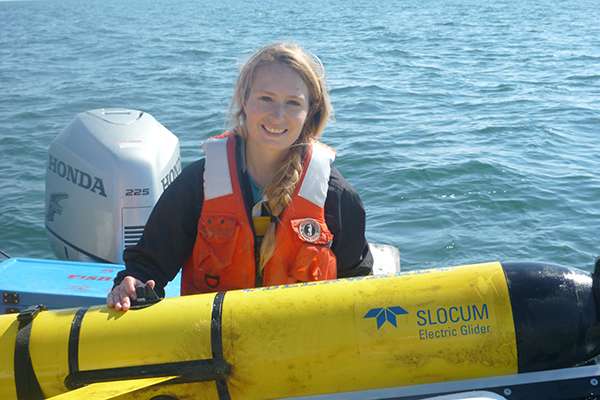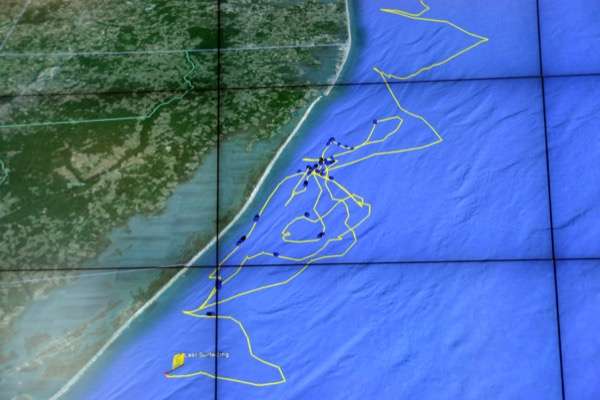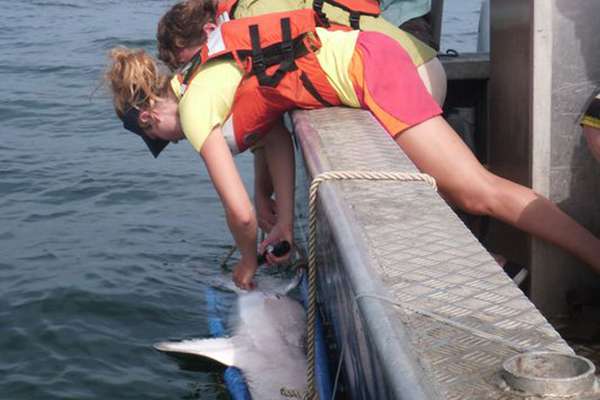New findings about sand tiger shark habitat, migration in Delaware coastal ocean

University of Delaware doctoral student Danielle Haulsee is the lead author on a paper reporting the combined use of underwater robotics and acoustic telemetry to understand sand tiger shark habitat and migration in the Delaware coastal ocean.
The paper, titled "Habitat Selection of a Coastal Predator from an Autonomous Underwater Vehicle," appeared in the May 28 issue of in Marine Ecology Progress Series, a top marine ecology journal.
"Other researchers have used robotics and acoustic telemetry separately; we were the first to bring those two technologies together to study habitat selection," Haulsee said.
Using robotics to inform conservation
Sand tiger sharks are an important predator in the Delaware Bay and coastal ocean and they play a key role in the ecological balance of the region. Still, their population numbers have dwindled in recent years, making conservation efforts important.
Through an ongoing project, Haulsee and her collaborators have spent the past several years tagging dozens of sand tiger sharks off Delaware's coast and analyzing the data collected to learn about their real-time migration patterns and habitat preferences.
The system, however, is passive and relies on the tagged animals coming near receivers strategically placed near coasts, in the bay or in other naturally constraining environments for their presence to be recorded.
Instead of waiting for sharks to swim by static receivers, the research team decided in October 2012 to send an autonomous underwater vehicle (AUV) called a glider to areas where they thought the sharks might be.
"People said, 'You can't do that, the ocean's too big,'" Haulsee said. But the researchers did it anyway.

Deployed just offshore of Delaware's Indian River Inlet, the glider actively listened for sharks equipped with acoustic telemetry tags while it zigzagged down the coast toward Chincoteague, Virginia.
"We didn't know what to expect, but then we started hearing from many sharks off the coast of Fenwick," Haulsee said.
Because the glider can be programmed remotely, the team was able to re-route the glider back to the area to determine whether the sharks were resting in deeper waters or simply migrating through the area. When the glider arrived, the sharks it originally detected were gone, but new sharks were present.
In fact, over a 19-day deployment, the glider never detected the same shark twice, despite the fact that there were about 300 actively tagged sharks in the area. The glider heard from 23 acoustic tags, in addition to transmissions from 200 additional active tags recorded by stationary receivers.
In addition to recording the sharks' movements, the glider also measured underwater environmental variables like temperature, oxygen, salinity and chlorophyll.
"Satellite data only gives you an idea of what the surface is like. We wanted to know what the underwater habitat is like where the sharks are and compare that to where the sharks aren't," she said.
While the sharks didn't show any selectivity for temperature in the study period, they did choose fresher water sites with lower salinity, which the research team related to the fresher waters coming out of the bay. They also selected sites closer to the shore rather than being further offshore.
Most interestingly, sand tiger sharks selected habitats that included high levels of color-dissolved organic matter, which, according to Haulsee, has never been connected to a marine species before.

"Color-dissolved organic matter has a certain yellowish color and scientists don't know exactly what it's comprised of, except to say it's the dissolved plant and animal material left in the water," explained Haulsee.
"We found that this organic material was not coming from the estuary or from the surface water; rather, it was coming from the bottom and being re-suspended in the water column, we suspect by wave action, weather or tides."
The UD researchers theorize that the sand tiger sharks may be attracted to this color-dissolved organic matter because it is nutrient-rich and therefore is related to productive food webs, which would support ideas that the Delaware Bay and coastal waters are a restorative summer resting and feeding place for sand tiger sharks before they migrate south in the fall.
"It's hard to say whether the sand tiger sharks use this area of the Delaware coastal ocean as a landmark, or whether they are there because they are looking for food," Haulsee explained.
Future work
Haulsee is now building a predictive model of where the sharks are throughout the year based on the robotics data and sea surface satellite data collected to-date to create predictive maps so people can avoid them.
"One reason we think their populations have declined so much is incidental bycatch in other fisheries. If we can tell people where they are, hopefully people can avoid catching them unintentionally," she said.
More information: "Habitat selection of a coastal shark species estimated from an autonomous underwater vehicle." www.int-res.com/articles/meps_oa/m528p277.pdf
Journal information: Marine Ecology Progress Series
Provided by University of Delaware



















